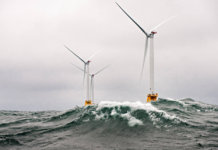A new white paper from economists at The Brattle Group has examined how the wind industry could use standard electric and gas forward contracts to hedge its revenue to reduce risk over mid- to long-term horizons.
The white paper also demonstrates how to set effective hedge ratios to reduce merchant risk for a wind project when a utility purchase power agreement (PPA) is not available. The firm says its recommendations take into account the complexities of the seasonal and intraday timing of wind output and how it tends to be negatively correlated with spot power prices.
The steady and rapid growth of renewable generation resources in the U.S. over the last several years has caused many states to be well ahead of their renewable portfolio standard targets, the firm explains.
Accordingly, there is increasing interest in developing renewables as merchant assets not secured under a long-term PPA for their energy or renewable energy credits (REC) back to a utility.
The Brattle white paper demonstrates hedging methods from the point of view of a single wind asset, as opposed to a plant embedded in a large generation portfolio. The authors point out that the portfolio problem is a more diversified one, but the approaches demonstrated in their analysis are still applicable to what could be done on the margin to a portfolio as more wind is included in the fleet and region.
Although wind assets in the Electric Reliability Council of Texas region are the focus of the white paper, many of the analytical concepts presented could also apply to solar energy, and the framework is applicable in other market regions (subject to adjustments for features such as capacity pricing), says Brattle.
“Due to the uncertain volume of production from a weather-dependent resource, it will be impossible to fully or perfectly hedge, especially over very short horizons,” says C. Onur Aydin, a Brattle senior associate and co-author of the white paper. “However, the average output from a renewable resource over horizons of a year or longer is more predictable and can be hedged, and it is not risk-minimizing to simply sell this expected amount of output forward at a trading hub.”
The authors discuss how the volume of wind generation will generally have a negative correlation with spot market power prices, considering wind tends to blow more heavily at off-peak periods, and when it blows more than expected, it also tends to depress prices (in areas where there is a significant renewable participation in the market).
As a result, the report says, the average forward price for available electric hedges will likely be higher than the average spot price received by wind assets, and variances will not have symmetric price effects. (The extent of these effects will also vary seasonally.) Thus, the appropriate hedge ratio must be determined with consideration of several risk factors.
Brattle also discusses that standard gas forwards could also be used as hedges for wind output – provided there is a strong and persistent correlation between gas and spot electric prices, there are good seasonal estimates of the conversion from gas to electricity via expected market heat rates, and the basis risk for gas delivery locations vs. power sales locations is taken into account. The authors note that these can all be managed, but they likely require a structural forecast of market conditions over a horizon of more than a few years because the ongoing penetration of more renewables will itself change the gas-electric correlations over time.
The white paper, “Managing Price Risk for Merchant Renewable Investments: Role of Market Interactions and Dynamics on Effective Hedging Strategies,” is authored by Aydin and Brattle principals Frank Graves and Bente Villadsen. It is available here.




